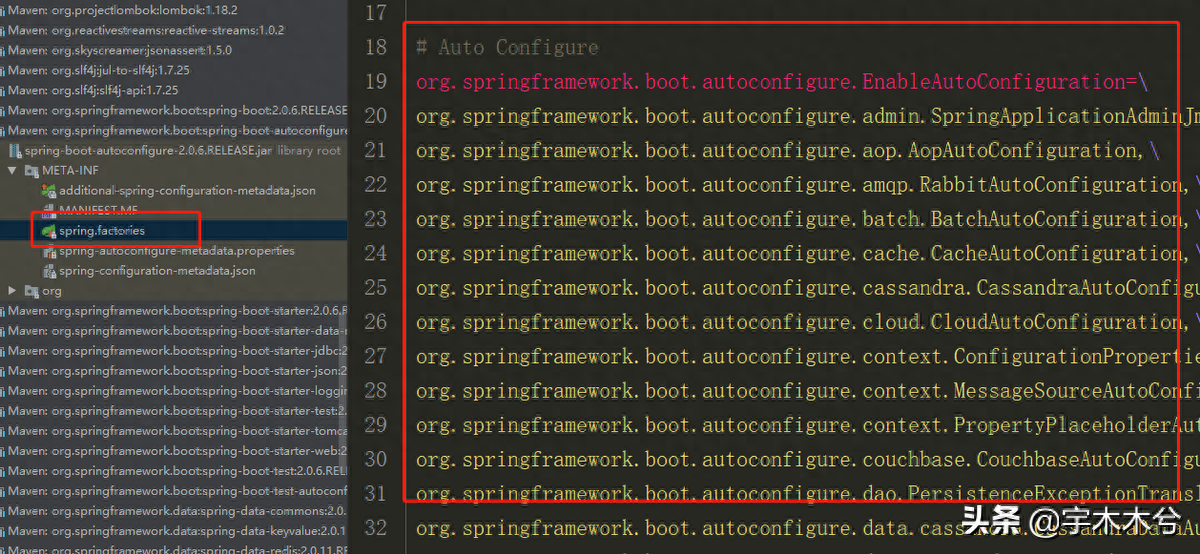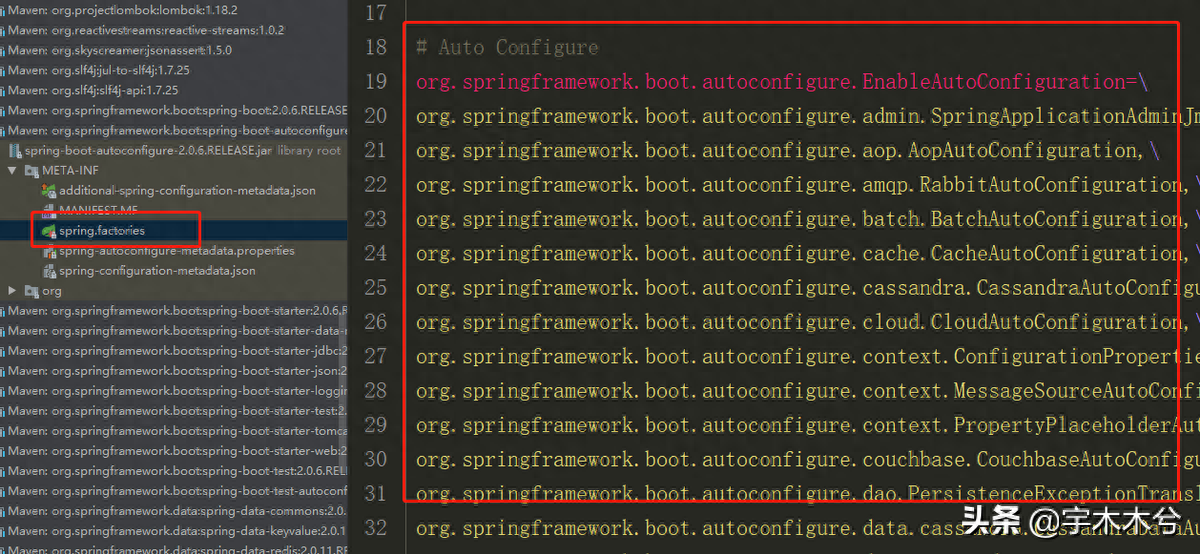
学习目标
- 理解自动装配的核心原理
- 能手写一个EnableAutoConfiguration注解
- 理解SPI机制的原理
第1章 集成Redis
1、引入依赖包
<dependency>
<groupId>org.springframework.boot</groupId>
<artifactId>spring-boot-starter-data-redis</artifactId>
</dependency>2、配置参数
spring.redis.host=192.168.8.74
spring.redis.password=123456
spring.redis.database=03、controller
package com.example.springbootvipjtdemo.redisdemo;
import org.springframework.beans.factory.annotation.Autowired;
import org.springframework.data.redis.core.RedisTemplate;
import org.springframework.web.bind.annotation.GetMapping;
import org.springframework.web.bind.annotation.RequestMapping;
import org.springframework.web.bind.annotation.RequestParam;
import org.springframework.web.bind.annotation.RestController;
/**
* @author Eclipse_2019
* @create 2022/6/9 14:36
*/
@RestController
@RequestMapping("/redis")
public class RedisController {
@Autowired
private RedisTemplate redisTemplate;
@GetMapping("/save")
public String save(@RequestParam String key,@RequestParam String value){
redisTemplate.opsForValue().set(key,value);
return "添加成功";
}
@GetMapping("/get")
public String get(@RequestParam String key){
String value = (String)redisTemplate.opsForValue().get(key);
return value;
}
}通过上面的案例,我们就能看出来,RedisTemplate这个类的bean对象,我们并没有通过XML的方式也没有通过注解的方式注入到IoC容器中去,但是我们就是可以通过@Autowired注解自动从容器里面拿到相应的Bean对象,再去进行属性注入。
那这是怎么做到的呢?接下来我们来分析一下自动装配的原理,等我们弄明白了原理,自然而然你们就懂了RedisTemplate的bean对象怎么来的。
第2章 自动装配原理
1、SpringBootApplication注解是入口
@Target(ElementType.TYPE) // 注解的适用范围,其中TYPE用于描述类、接口(包括包注解类型)或enum声明
@Retention(RetentionPolicy.RUNTIME) // 注解的生命周期,保留到class文件中(三个生命周期)
@Documented // 表明这个注解应该被javadoc记录
@Inherited // 子类可以继承该注解
@SpringBootConfiguration // 继承了Configuration,表示当前是注解类
@EnableAutoConfiguration // 开启springboot的注解功能,springboot的四大神器之一,其借助@import的帮助
@ComponentScan(excludeFilters = { // 扫描路径设置
@Filter(type = FilterType.CUSTOM, classes = TypeExcludeFilter.class),
@Filter(type = FilterType.CUSTOM, classes = AutoConfigurationExcludeFilter.class) })
public @interface SpringBootApplication {
...
}在其中比较重要的有三个注解,分别是:
- @SpringBootConfiguration:继承了Configuration,表示当前是注解类。
- @EnableAutoConfiguration: 开启springboot的注解功能,springboot的四大神器之一,其借助@import的帮助。
- @ComponentScan(excludeFilters = { // 扫描路径设置(具体使用待确认)。
(1)ComponentScan
ComponentScan的功能其实就是自动扫描并加载符合条件的组件(比如@Component和@Repository等)或者bean定义;并将这些bean定义加载到IoC容器中。
我们可以通过basePackages等属性来细粒度的定制@ComponentScan自动扫描的范围,如果不指定,则默认Spring框架实现会从声明@ComponentScan所在类的package进行扫描。
注:所以SpringBoot的启动类最好是放在root package下,因为默认不指定basePackages。
(2)EnableAutoConfiguration
此注解顾名思义是可以自动配置,所以应该是springboot中最为重要的注解。
@Target(ElementType.TYPE)
@Retention(RetentionPolicy.RUNTIME)
@Documented
@Inherited
@AutoConfigurationPackage
@Import(AutoConfigurationImportSelector.class)//【重点注解】
public @interface EnableAutoConfiguration {
...
}其中最重要的两个注解:
- @AutoConfigurationPackage
- @Import(AutoConfigurationImportSelector.class)
当然还有其中比较重要的一个类就是:AutoConfigurationImportSelector.class。
AutoConfigurationPackage
@Target(ElementType.TYPE)
@Retention(RetentionPolicy.RUNTIME)
@Documented
@Inherited
@Import(AutoConfigurationPackages.Registrar.class)
public @interface AutoConfigurationPackage {
}通过@Import(AutoConfigurationPackages.Registrar.class)
static class Registrar implements ImportBeanDefinitionRegistrar, DeterminableImports {
@Override
public void registerBeanDefinitions(AnnotationMetadata metadata,
BeanDefinitionRegistry registry) {
register(registry, new PackageImport(metadata).getPackageName());
}
……
}注册当前启动类的根package;注册org.springframework.boot.autoconfigure.AutoConfigurationPackages的BeanDefinition。
AutoConfigurationPackage注解的作用是将添加该注解的类所在的package作为自动配置package 进行管理。
可以通过 AutoConfigurationPackages 工具类获取自动配置package列表。当通过注解@SpringBootApplication标注启动类时,已经为启动类添加了@AutoConfigurationPackage注解。路径为 @SpringBootApplication -> @EnableAutoConfiguration -> @AutoConfigurationPackage。也就是说当SpringBoot应用启动时默认会将启动类所在的package作为自动配置的package。
如我们创建了一个sbia-demo的应用,下面包含一个启动模块demo-bootstrap,启动类时Bootstrap,它添加了@SpringBootApplication注解,我们通过测试用例可以看到自动配置package为com.tm.sbia.demo.boot。

AutoConfigurationImportSelector

可以从图中看出AutoConfigurationImportSelector实现了 DeferredImportSelector 从 ImportSelector继承的方法:selectImports。
@Override
public String[] selectImports(AnnotationMetadata annotationMetadata) {
if (!isEnabled(annotationMetadata)) {
return NO_IMPORTS;
}
AutoConfigurationMetadata autoConfigurationMetadata = AutoConfigurationMetadataLoader
.loadMetadata(this.beanClassLoader);
AnnotationAttributes attributes = getAttributes(annotationMetadata);
List<String> configurations = getCandidateConfigurations(annotationMetadata,
attributes);
configurations = removeDuplicates(configurations);
Set<String> exclusions = getExclusions(annotationMetadata, attributes);
checkExcludedClasses(configurations, exclusions);
configurations.removeAll(exclusions);
configurations = filter(configurations, autoConfigurationMetadata);
fireAutoConfigurationImportEvents(configurations, exclusions);
return StringUtils.toStringArray(configurations);
}第9行List configurations =getCandidateConfigurations(annotationMetadata,`attributes);其实是去加载各个组件jar下的 public static final String FACTORIES_RESOURCE_LOCATION = "META-INF/spring.factories";外部文件。
如果获取到类信息,spring可以通过类加载器将类加载到jvm中,现在我们已经通过spring-boot的starter依赖方式依赖了我们需要的组件,那么这些组件的类信息在select方法中就可以被获取到。
protected List<String> getCandidateConfigurations(AnnotationMetadata metadata, AnnotationAttributes attributes) {
List<String> configurations = SpringFactoriesLoader.loadFactoryNames(this.getSpringFactoriesLoaderFactoryClass(), this.getBeanClassLoader());
Assert.notEmpty(configurations, "No auto configuration classes found in META-INF/spring.factories. If you are using a custom packaging, make sure that file is correct.");
return configurations;
}其返回一个自动配置类的类名列表,方法调用了loadFactoryNames方法,查看该方法。
public static List<String> loadFactoryNames(Class<?> factoryClass, @Nullable ClassLoader classLoader) {
String factoryClassName = factoryClass.getName();
return (List)loadSpringFactories(classLoader).getOrDefault(factoryClassName, Collections.emptyList());
}自动配置器会跟根据传入的factoryClass.getName()到项目系统路径下所有的spring.factories文件中找到相应的key,从而加载里面的类。
这个外部文件,有很多自动配置的类。如下:

其中,最关键的要属@Import(AutoConfigurationImportSelector.class),借助AutoConfigurationImportSelector,@EnableAutoConfiguration可以帮助SpringBoot应用将所有符合条件(spring.factories)的bean定义(如Java Config@Configuration配置)都加载到当前SpringBoot创建并使用的IoC容器。
(3)SpringFactoriesLoader
其实SpringFactoriesLoader的底层原理就是借鉴于JDK的SPI机制,所以,在将SpringFactoriesLoader之前,我们现在发散一下SPI机制。
SPI
SPI ,全称为 Service Provider Interface,是一种服务发现机制。它通过在ClassPath路径下的META-INF/services文件夹查找文件,自动加载文件里所定义的类。这一机制为很多框架扩展提供了可能,比如在Dubbo、JDBC中都使用到了SPI机制。我们先通过一个很简单的例子来看下它是怎么用的。
例子
首先,我们需要定义一个接口,SPIService。
package com.example.springbootvipjtdemo.spidemo;
/**
* @author Eclipse_2019
* @create 2022/6/8 17:55
*/
public interface SPIService {
void doSomething();
}然后,定义两个实现类,没别的意思,只输入一句话。
package com.example.springbootvipjtdemo.spidemo;
/**
* @author Eclipse_2019
* @create 2022/6/8 17:56
*/
public class SpiImpl1 implements SPIService{
@Override
public void doSomething() {
System.out.println("第一个实现类干活。。。");
}
}
----------------------我是乖巧的分割线----------------------
package com.example.springbootvipjtdemo.spidemo;
/**
* @author Eclipse_2019
* @create 2022/6/8 17:56
*/
public class SpiImpl2 implements SPIService{
@Override
public void doSomething() {
System.out.println("第二个实现类干活。。。");
}
}最后呢,要在ClassPath路径下配置添加一个文件。文件名字是接口的全限定类名,内容是实现类的全限定类名,多个实现类用换行符分隔。
文件路径如下:

内容就是实现类的全限定类名:
com.example.springbootvipjtdemo.spidemo.SpiImpl1
com.example.springbootvipjtdemo.spidemo.SpiImpl2测试
然后我们就可以通过ServiceLoader.load或者Service.providers方法拿到实现类的实例。其中,Service.providers包位于sun.misc.Service,而ServiceLoader.load包位于java.util.ServiceLoader。
public class TestSPI {
public static void main(String[] args) {
Iterator<SPIService> providers = Service.providers(SPIService.class);
ServiceLoader<SPIService> load = ServiceLoader.load(SPIService.class);
while(providers.hasNext()) {
SPIService ser = providers.next();
ser.doSomething();
}
System.out.println("--------------------------------");
Iterator<SPIService> iterator = load.iterator();
while(iterator.hasNext()) {
SPIService ser = iterator.next();
ser.doSomething();
}
}
}两种方式的输出结果是一致的:
第一个实现类干活。。。
第二个实现类干活。。。
--------------------------------
第一个实现类干活。。。
第二个实现类干活。。。源码分析
我们看到一个位于sun.misc包,一个位于java.util包,sun包下的源码看不到。我们就以ServiceLoader.load为例,通过源码看看它里面到底怎么做的。
ServiceLoader
首先,我们先来了解下ServiceLoader,看看它的类结构。
public final class ServiceLoader<S> implements Iterable<S>
//配置文件的路径
private static final String PREFIX = "META-INF/services/";
//加载的服务类或接口
private final Class<S> service;
//已加载的服务类集合
private LinkedHashMap<String,S> providers = new LinkedHashMap<>();
//类加载器
private final ClassLoader loader;
//内部类,真正加载服务类
private LazyIterator lookupIterator;
}Load
load方法创建了一些属性,重要的是实例化了内部类,LazyIterator。最后返回ServiceLoader的实例。
public final class ServiceLoader<S> implements Iterable<S>
private ServiceLoader(Class<S> svc, ClassLoader cl) {
//要加载的接口
service = Objects.requireNonNull(svc, "Service interface cannot be null");
//类加载器
loader = (cl == null) ? ClassLoader.getSystemClassLoader() : cl;
//访问控制器
acc = (System.getSecurityManager() != null) ? AccessController.getContext() : null;
//先清空
providers.clear();
//实例化内部类
LazyIterator lookupIterator = new LazyIterator(service, loader);
}
}查找实现类
查找实现类和创建实现类的过程,都在LazyIterator完成。当我们调用iterator.hasNext和iterator.next方法的时候,实际上调用的都是LazyIterator的相应方法。
public Iterator<S> iterator() {
return new Iterator<S>() {
public boolean hasNext() {
return lookupIterator.hasNext();
}
public S next() {
return lookupIterator.next();
}
.......
};
}所以,我们重点关注lookupIterator.hasNext()方法,它最终会调用到hasNextService。
private class LazyIterator implements Iterator<S>{
Class<S> service;
ClassLoader loader;
Enumeration<URL> configs = null;
Iterator<String> pending = null;
String nextName = null;
private boolean hasNextService() {
//第二次调用的时候,已经解析完成了,直接返回
if (nextName != null) {
return true;
}
if (configs == null) {
//META-INF/services/ 加上接口的全限定类名,就是文件服务类的文件
//META-INF/services/com.viewscenes.netsupervisor.spi.SPIService
String fullName = PREFIX + service.getName();
//将文件路径转成URL对象
configs = loader.getResources(fullName);
}
while ((pending == null) || !pending.hasNext()) {
//解析URL文件对象,读取内容,最后返回
pending = parse(service, configs.nextElement());
}
//拿到第一个实现类的类名
nextName = pending.next();
return true;
}
}创建实例
当然,调用next方法的时候,实际调用到的是,lookupIterator.nextService。它通过反射的方式,创建实现类的实例并返回。
private class LazyIterator implements Iterator<S>{
private S nextService() {
//全限定类名
String cn = nextName;
nextName = null;
//创建类的Class对象
Class<?> c = Class.forName(cn, false, loader);
//通过newInstance实例化
S p = service.cast(c.newInstance());
//放入集合,返回实例
providers.put(cn, p);
return p;
}
}看到这儿,我想已经很清楚了。获取到类的实例,我们自然就可以对它为所欲为了!
JDBC中的应用
我们开头说,SPI机制为很多框架的扩展提供了可能,其实JDBC就应用到了这一机制。回忆一下JDBC获取数据库连接的过程。在早期版本中,需要先设置数据库驱动的连接,再通过DriverManager.getConnection获取一个Connection。
String url = "jdbc:mysql:///consult?serverTimezone=UTC";
String user = "root";
String password = "root";
Class.forName("com.mysql.jdbc.Driver");
Connection connection = DriverManager.getConnection(url, user, password);在较新版本中(具体哪个版本,笔者没有验证),设置数据库驱动连接,这一步骤就不再需要,那么它是怎么分辨是哪种数据库的呢?答案就在SPI。
加载
我们把目光回到DriverManager类,它在静态代码块里面做了一件比较重要的事。很明显,它已经通过SPI机制, 把数据库驱动连接初始化了。
public class DriverManager {
static {
loadInitialDrivers();
println("JDBC DriverManager initialized");
}
}具体过程还得看loadInitialDrivers,它在里面查找的是Driver接口的服务类,所以它的文件路径就是:META-INF/services/java.sql.Driver。
public class DriverManager {
private static void loadInitialDrivers() {
AccessController.doPrivileged(new PrivilegedAction<Void>() {
public Void run() {
//很明显,它要加载Driver接口的服务类,Driver接口的包为:java.sql.Driver
//所以它要找的就是META-INF/services/java.sql.Driver文件
ServiceLoader<Driver> loadedDrivers = ServiceLoader.load(Driver.class);
Iterator<Driver> driversIterator = loadedDrivers.iterator();
try{
//查到之后创建对象
while(driversIterator.hasNext()) {
driversIterator.next();
}
} catch(Throwable t) {
// Do nothing
}
return null;
}
});
}
}那么,这个文件哪里有呢?我们来看MySQL的jar包,就是这个文件,文件内容为:
com.mysql.cj.jdbc.Driver。

创建实例
上一步已经找到了MySQL中的com.mysql.jdbc.Driver全限定类名,当调用next方法时,就会创建这个类的实例。它就完成了一件事,向DriverManager注册自身的实例。
public class Driver extends NonRegisteringDriver implements java.sql.Driver {
static {
try {
//注册
//调用DriverManager类的注册方法
//往registeredDrivers集合中加入实例
java.sql.DriverManager.registerDriver(new Driver());
} catch (SQLException E) {
throw new RuntimeException("Can't register driver!");
}
}
public Driver() throws SQLException {
// Required for Class.forName().newInstance()
}
}创建Connection
在DriverManager.getConnection()方法就是创建连接的地方,它通过循环已注册的数据库驱动程序,调用其connect方法,获取连接并返回。
private static Connection getConnection(
String url, java.util.Properties info, Class<?> caller) throws SQLException {
//registeredDrivers中就包含com.mysql.cj.jdbc.Driver实例
for(DriverInfo aDriver : registeredDrivers) {
if(isDriverAllowed(aDriver.driver, callerCL)) {
try {
//调用connect方法创建连接
Connection con = aDriver.driver.connect(url, info);
if (con != null) {
return (con);
}
}catch (SQLException ex) {
if (reason == null) {
reason = ex;
}
}
} else {
println(" skipping: " + aDriver.getClass().getName());
}
}
}再扩展
既然我们知道JDBC是这样创建数据库连接的,我们能不能再扩展一下呢?如果我们自己也创建一个java.sql.Driver文件,自定义实现类MyDriver,那么,在获取连接的前后就可以动态修改一些信息。
还是先在项目ClassPath下创建文件,文件内容为自定义驱动类com.viewscenes.netsupervisor.spi.MyDriver我们的MyDriver实现类,继承自MySQL中的NonRegisteringDriver,还要实现java.sql.Driver接口。这样,在调用connect方法的时候,就会调用到此类,但实际创建的过程还靠MySQL完成。
package com.viewscenes.netsupervisor.spi
public class MyDriver extends NonRegisteringDriver implements Driver{
static {
try {
java.sql.DriverManager.registerDriver(new MyDriver());
} catch (SQLException E) {
throw new RuntimeException("Can't register driver!");
}
}
public MyDriver()throws SQLException {}
public Connection connect(String url, Properties info) throws SQLException {
System.out.println("准备创建数据库连接.url:"+url);
System.out.println("JDBC配置信息:"+info);
info.setProperty("user", "root");
Connection connection = super.connect(url, info);
System.out.println("数据库连接创建完成!"+connection.toString());
return connection;
}
}
--------------------输出结果---------------------
准备创建数据库连接.url:jdbc:mysql:///consult?serverTimezone=UTC
JDBC配置信息:{user=root, password=root}
数据库连接创建完成!com.mysql.cj.jdbc.ConnectionImpl@7cf10a6f(2)回到SpringFactoriesLoader
借助于Spring框架原有的一个工具类:SpringFactoriesLoader的支持,@EnableAutoConfiguration可以智能的自动配置功效才得以大功告成!
SpringFactoriesLoader属于Spring框架私有的一种扩展方案,其主要功能就是从指定的配置文件META-INF/spring.factories加载配置,加载工厂类。
SpringFactoriesLoader为Spring工厂加载器,该对象提供了loadFactoryNames方法,入参为factoryClass和classLoader即需要传入工厂类名称和对应的类加载器,方法会根据指定的classLoader,加载该类加器搜索路径下的指定文件,即spring.factories文件。
传入的工厂类为接口,而文件中对应的类则是接口的实现类,或最终作为实现类。
public abstract class SpringFactoriesLoader {
//...
public static <T> List<T> loadFactories(Class<T> factoryClass, ClassLoader classLoader) {
...
}
public static List<String> loadFactoryNames(Class<?> factoryClass, ClassLoader classLoader) {
....
}
}配合@EnableAutoConfiguration使用的话,它更多是提供一种配置查找的功能支持,即根据@EnableAutoConfiguration的完整类名org.springframework.boot.autoconfigure.EnableAutoConfiguration作为查找的Key,获取对应的一组@Configuration类

上图就是从SpringBoot的autoconfigure依赖包中的META-INF/spring.factories配置文件中摘录的一段内容,可以很好地说明问题。
(重点)所以,@EnableAutoConfiguration自动配置的魔法其实就变成了:
从classpath中搜寻所有的META-INF/spring.factories配置文件,并将其中
org.springframework.boot.autoconfigure.EnableAutoConfiguration对应的配置项通过反射(Java Refletion)实例化为对应的标注了@Configuration的JavaConfig形式的IoC容器配置类,然后汇总为一个并加载到IoC容器。
第3章 补充内容
- @Target 注解可以用在哪。TYPE表示类型,如类、接口、枚举@Target(ElementType.TYPE) //接口、类、枚举@Target(ElementType.FIELD) //字段、枚举的常量@Target(ElementType.METHOD) //方法@Target(ElementType.PARAMETER) //方法参数@Target(ElementType.CONSTRUCTOR) //构造函数@Target(ElementType.LOCAL_VARIABLE)//局部变量@Target(ElementType.ANNOTATION_TYPE)//注解@Target(ElementType.PACKAGE) ///包
- @Retention 注解的保留位置。只有RUNTIME类型可以在运行时通过反射获取其值@Retention(RetentionPolicy.SOURCE) //注解仅存在于源码中,在class字节码文件中不包含@Retention(RetentionPolicy.CLASS) // 默认的保留策略,注解会在class字节码文件中存在,但运行时无法获得,@Retention(RetentionPolicy.RUNTIME) // 注解会在class字节码文件中存在,在运行时可以通过反射获取到
- @Documented 该注解在生成javadoc文档时是否保留
- @Inherited 被注解的元素,是否具有继承性,如子类可以继承父类的注解而不必显式的写下来。

































